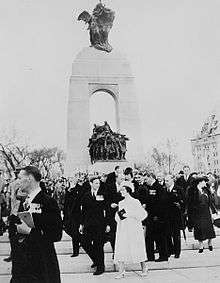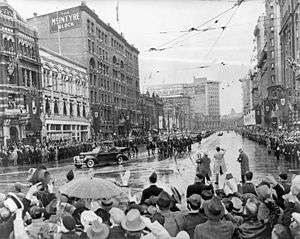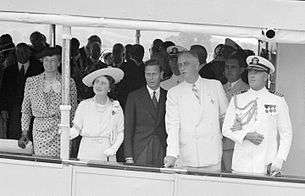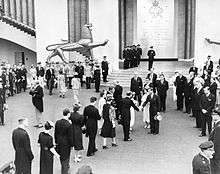1939 royal tour of Canada

The 1939 royal tour of Canada was a cross-Canada royal tour by King George VI and Queen Elizabeth, lasting from May 17 to June 15, 1939, including a visit to the United States June 7–12. It was one of the first visits of a reigning monarch to Canada (in 1926, Queen Marie of Romania also visited Canada[1]), and also the first time a British monarch had set foot in the United States. The royal couple visited every Canadian province as well as the Dominion of Newfoundland. The tour was an enormous event, attracting huge crowds at each new city.
The royals arrived in Quebec City and travelled west by rail through the country, visiting most of the major cities and finally arriving in Vancouver. Then they travelled through the United States, along with Canadian Prime Minister Mackenzie King. The tour ended with a visit to the Maritimes and Newfoundland, departing from Halifax.
This tour marked the first time that the sovereign's official Canadian birthday was marked with the monarch himself present in the country; the occasion was marked on Parliament Hill with a celebration and a Trooping of the Colour. In 1985, during a tour of Canada, Queen Elizabeth, by then the Queen Mother, stated in a speech: "It is now some 46 years since I first came to this country with the King, in those anxious days shortly before the outbreak of the Second World War. I shall always look back upon that visit with feelings of affection and happiness. I think I lost my heart to Canada and Canadians, and my feelings have not changed with the passage of time."[2]
Arrival in Quebec

_BAnQ_P48S1P04233.jpg)
Governor General Lord Tweedsmuir, in an effort to foster Canadian identity, conceived of a royal tour by the country's monarchs; an idea that the official royal visit historian, Gustave Lanctot, opined in his official account of the visit, "probably grew out of the knowledge that at his coming Coronation, George VI was to assume the additional title of King of Canada." Tweedsmuir's desire was to demonstrate with living example the fact of Canada's status as an independent kingdom, having Canadians "see their King performing royal functions, supported by his Canadian ministers." Prime Minister Mackenzie King, while in London for the coronation in May 1937, formally consulted with the King on the matter. According to biographer J. A. Smith, the task for Tweedsmuir, and the Canadian government, was "how to translate the Statute of Westminster into the actualities of a tour... since this was the first visit of a reigning monarch to a Dominion, and precedents were being made.[3] According to the official Royal Tour historian Gustave Lanctot, George VI was to be present in Canada as a living example of Canada's status as an independent kingdom.
The arrangements were made and on 17 May 1939, King George VI and Queen Elizabeth The Queen Mother arrived for their tour of Canada on board the Canadian Pacific liner RMS Empress of Australia; the reception at Quebec City, where they landed, Trois-Rivières and Montreal were positive beyond expectations,[4][5] and the King impressed Quebeckers when he responded to the welcoming remarks in French.[5][6] Queen Elizabeth wore elements from an all-white wardrobe, her clothes for the 1938 Royal visit to France having quickly been remade in that colour, because of the death of her mother, the Countess of Strathmore and Kinghorne - this is very noticeable in all images from the time. Their Majesties took up residence at La Citadelle, where the King performed his first official tasks, amongst which was the acceptance of Daniel Calhoun Roper as the American envoy to Canada. The King also held audience with Quebecers in the Legislative Council chamber of the Legislative Assembly Building.[7] Two Boer War veterans of Scottish heritage, in order to settle an argument, asked the Queen when presented to her: "Are you Scots, or are you English?" Elizabeth's response was reported as being: "Since I have landed in Quebec, I think we can say that I am Canadian."[8]
Ottawa and Toronto

The royal party traveled to Ottawa on May 20, where the Queen laid the cornerstone of the Supreme Court building,[9] the King dedicated the National War Memorial in front of 10,000 war veterans,[6] amongst whom the Queen requested she be able to walk,[10] and the couple went to parliament. There, the King personally granted Royal Assent to nine bills in the traditional manner which was still being used in Canada at the time - in the United Kingdom, Royal Assent has not been granted by the Sovereign in person since 1854. Following the ceremony, His Majesty stated: "No ceremony could more completely symbolize the free and equal association of the nations of the Commonwealth." After two days in Ottawa, the royal couple began traveling westward.[11]
The couple traveled to Toronto on May 22, where they attended the King's Plate horse race, dedicated the soon-to-be completed Rainbow Bridge at Niagara Falls, and unveiled a monument at the site to mark the occasion. They also inaugurated the Queen Elizabeth Way, which was named for George's royal consort, as well as various monuments along the route, including a set of decorative stone pillars on the eastern approach to the Henley Bridge in St. Catharines, each consisting of a regal lion bearing a unique shield, and the Queen Elizabeth Way Monument, which had inscribed on its base words prophetically referring to the hostilities that would break out later that year:
- "The Queen Elizabeth Way was opened by the King and Queen in June, 1939, marking the first visit of a reigning sovereign to a sister Dominion of the Empire. The courage and resolution of Their Majesties in undertaking the royal visit in face of imminent war have inspired the people of this province to complete this work in the Empire's darkest hour, in full confidence of victory and a lasting peace."
Westward leg


The Royal Train was operated by Canadian Pacific Railway on the western leg of the tour and the couple continued to be greeted by throngs of Canadians, even in the immigrant-rich but Depression battered Prairies.
The couple visited Winnipeg and Brandon on May 24. Upon their arrival in Winnipeg, on the King's official birthday, the royal couple was greeted by an estimated 100,000 people (including several thousand Americans), and, to allow them all a view of himself and the Queen, His Majesty requested that the convertible roof of their limousine be opened, despite a record rainfall that day.[12][13] While staying at Government House in Winnipeg, the King made his longest ever radio broadcast to the British Empire;[14] the table at which he sat remains in the Aides Room of the royal residence.[15] Then Prime Minister of Canada William Lyon Mackenzie King described the arrival of the royal train at Brandon as: "Wonderful cheering. A long bridge overhead crowded with people. The hour: 11 at night... the finest scene on the entire trip."[13][14] The Queen herself said the reception was "the biggest thrill of the tour."[14]
Continuing westward across the Prairies, the Royal Train arrived in Regina on May 25, followed by Calgary on May 26 and Banff on May 27.
The royal train arrived in the town of Melville at 10:00 pm on 3 June, attracting over 60,000 people to the town of 3,000. The stop was only meant to last ten minutes, after which the train would stay overnight for servicing. But, with the throngs of people who arrived, the royal party decided to extend the visit to a half-hour, after which the train pulled away, returning a few hours later, once the crowds had dispersed;[16] Canadian Press reporter R. J. Carnegie said of the stop: "Never throughout the tour did I see such unbridled enthusiasm as then." On 4 June, the King and Queen took a brief walk around Unity, and in Saskatoon, where the royal couple visited the University of Saskatchewan, some 150,000 people turned out to see the monarchs, and hundreds of teenage girls dressed in red, white, and blue assembled in the image of a Royal Union Flag and sang "God Save the King".[17][18]
When the royal couple arrived in Edmonton, the regular population of 90,000 swelled to more than 200,000, as Albertans from surrounding towns came in to catch sight of the King and Queen,[19] 70,000 people sat in specially constructed grandstands lining Kingsway, which had been renamed to honour the King, to see the royal motorcade.[20] At one night time stop in the Rocky Mountains, the royal couple sang along with an impromptu a cappella rendition of "When the Moon Comes over the Mountain" that broke out amongst the gathered crowd when the moon emerged from behind the clouds.[21]
British Columbia

The King and the Queen stopped in Vancouver, Victoria, and a number of other smaller communities in British Columbia. Mackenzie King was enthused, stating in his diary on May 29, 1939: "The day in Vancouver was one of the finest on the entire tour," and, the following day: "Without question, Victoria has left the most pleasing of all impressions. It was a crowning gem..."[22]
United States


In the United States June 7–12,[23] the King and Queen visited Washington, New York, and Poughkeepsie; they were accompanied by the Canadian prime minister, still Mackenzie King, as the sole minister in attendance to the King, rather than by any British minister, by way of reinforcing that George VI's visit to the United States was a visit from Canada,[3][24][25][26][27][28][29] despite the point that the King and Queen were presented by Secretary of State Cordell Hull to President Franklin D. Roosevelt as "Their Britannic Majesties."[30] For Mackenzie King, this assertion of Canada's status as a kingdom independent of Britain was a key motive behind the organization of the tour; he wrote in his diary on 17 May 1939: "I... told [the Queen] that I felt somewhat embarrassed about taking in the entire trip with Their Majesties; that it looked like pushing myself to the fore, yet I felt that unless some evidence of Dominion precedence existed, one of the main purposes of the trip would be gone. The Queen then said: The King and I felt right along that you should come with us."[31] Another factor, however, was public relations; the presence of the King and Queen, in both Canada and the United States, was calculated to shore up sympathy for Britain in anticipation of hostilities with Nazi Germany.[32][33]
The itinerary included visits to Mount Vernon on June 9, the 1939 New York World's Fair on June 10, and dinner at FDR's estate at Hyde Park on June 11, at which President Roosevelt served hotdogs, smoked turkey, and strawberry shortcake to their Majesties.[34][35] The 2012 film Hyde Park on Hudson contains a lengthy fictionalized depiction of the royal couple's visit to the Roosevelt estate.
Atlantic Canada
On June 12 the royal couple returned to Canada, visiting the maritime provinces. The King and the Queen stopped in Doaktown, New Brunswick, to take tea in a local teahouse, where, upon finishing, they proceeded to the kitchen and took the proprietors by surprise.[n 1]
Accompanied by the Governor of Newfoundland, Sir Humphrey Walwyn, the King and Queen were driven to St. John's to attend various official events, causing the city's population of 50,000 to double as visitors came in to see the royal couple. For the departure of the monarch, the residents of St. John's built a large bonfire on Signal Hill.[37]
After a visit to Charlottetown, Prince Edward Island, the royal couple ended their tour at Halifax, Nova Scotia, on June 15, where a farewell luncheon was held, and the King and Queen each delivered a speech of thanks. That evening, the royal couple boarded the RMS Empress of Britain to return to the United Kingdom; of their departure, Mackenzie King wrote in his diary: "The Empress of Britain ran past one end of the harbour where she was towed around, then came back the opposite way to pull out to sea. She was accompanied by British warships and our own destroyers. The Bluenose and other vessels also in the harbour as a sort of escort.... The King and Queen were at the very top of the ship and kept waving.... No farewell could have been finer...."[13]
See also
Notes
References
- ↑ https://news.google.com/newspapers?nid=1946&dat=19380719&id=1JEjAAAAIBAJ&sjid=dqgFAAAAIBAJ&pg=6052,2123265
- ↑ "CBC: Royal Visits to Canada". Cbc.ca. Archived from the original on 9 October 2010. Retrieved 2010-09-18.
- 1 2 "Galbraith, William; Canadian Parliamentary Review: "Fiftieth Anniversary of the 1939 Royal Visit"; Vol. 12, No. 3, 1989". Parl.gc.ca. 1997-09-24. Retrieved 2010-09-18.
- ↑ Hubbard; p. 191
- 1 2 Douglas, W.A.B.; Greenhous, Brereton (1995). Out of the Shadows: Canada in the Second World War. Toronto: Dundurn Press Ltd. p. 11. ISBN 1-55002-151-6. Retrieved 8 July 2011.
- 1 2 Douglas 1995, p. 17
- ↑ Toporoski, Richard (June 2006). "Can the Queen Grant Royal Assent in a Provincial Legislature?: No" (PDF). Canadian Monarchist News. Toronto: Monarchist League of Canada. Fall-Winter 2005 (24): 19. Archived from the original (PDF) on July 8, 2009. Retrieved 5 July 2009.
- ↑ Elizabeth II (2002). "Speech by Her Majesty Queen Elizabeth II". Written at Vancouver. In Department of Canadian Heritage. Ceremonial and Canadian Symbols Promotion > The Canadian Monarchy. Ottawa: Queen's Printer for Canada. Retrieved 7 November 2007.
- ↑ "Senate of Canada: Canada, a Constitutional Monarchy: George VI". Parl.gc.ca. Retrieved 2010-09-18.
- ↑ Douglas 1995, p. 18
- ↑ Douglas 1995, p. 19
- ↑ "On This Day > May 24, 1939". CBC. Retrieved 2 July 2009.
- 1 2 3 King, William L.M. (24 May 1939), "Diary", in Hoogenraad, Maureen, Biography and People > A Real Companion and Friend > Politics, Themes, and Events from King's Life > The Royal Tour of 1939, Ottawa: Queen's Printer for Canada, retrieved 24 June 2009
- 1 2 3 "Society > The Monarchy > Presenting 'Chief Sitting Albino'". CBC. Retrieved 2 July 2009.
- ↑ Office of the Lieutenant Governor of Manitoba. "History > Government House > Aides Room". Queen's Printer for Manitoba. Archived from the original on 13 February 2009. Retrieved 2 July 2009.
- ↑ Museum of Civilization. "Exhibitions > Online Exhibitions > 2. King Wheat - Saskatchewan Grain Elevator > 1939 Royal Tour". Queen's Printer for Canada. Retrieved 30 June 2009.
- ↑ "Society > The Monarchy > Melville's shining moment". CBC. Retrieved 30 June 2009.
- ↑ Office of Communications (8 January 1999). "1939 royal visit to Saskatoon and campus elicited outpouring of loyalty (and purple journalism)". On Campus News. Retrieved 30 June 2009.
- ↑ Bourdeau, Chris; Latta-Guthrie, Leslie (Summer 2005). "Centennial Happenings at the Provincial Archives" (PDF). Alberta Society of Archives Newsletter. Archives Society of Alberta. 24 (4). ISSN 1199-5122. Archived (PDF) from the original on December 12, 2014.
- ↑ Aubrey, Merrily K (2004), Naming Edmonton : from Ada to Zoie, (Edmonton Historical Board. Heritage Sites Committee) University of Alberta Press, p. 181, ISBN 0-88864-423-X, retrieved 10 July 2011
- ↑ Pigott, Peter (2005). Royal Transport: An Inside Look at the History of Royal Travel. Toronto: Dundurn Press. p. 21. ISBN 978-1-55002-572-9. Retrieved 8 July 2011.
- ↑ King, William L.M. (30 May 1939). "Diary". In Hoogenraad, Maureen. Biography and People > A Real Companion and Friend > Politics, Themes, and Events from King's Life > The Royal Tour of 1939. Ottawa: Queen's Printer for Canada. Retrieved 24 June 2009.
- ↑ "The British Royal Visit June 7–12, 1939". Franklin D. Roosevelt Presidential Library and Museum. Retrieved 2015-11-08.
- ↑ Bell, Peter (October 2002), "The Foreign Office and the 1939 Royal Visit to America: Courting the USA in an Era of Isolationism" (PDF), Journal of Contemporary History, 37 (4): 603, 611, doi:10.1177/00220094020370040601, retrieved 30 August 2010
- ↑ Bousfield, Arthur; Toffoli, Gary (1989). Royal Spring: The Royal Tour of 1939 and the Queen Mother in Canada. Toronto: Dundurn Press. pp. 60, 66. ISBN 1-55002-065-X.
- ↑ Douglas, W.A.B.; Greenhous, Brereton (1995), Out of the Shadows: Canada in the Second World War, Toronto: Dundurn Press Ltd., p. 11, ISBN 1-55002-151-6
- ↑ Lanctot, Gustave (1964). Royal Tour of King George VI and Queen Elizabeth in Canada and the United States of America 1939. Toronto: E.P. Taylor Foundation. ASIN B0006EB752.
- ↑ Tidridge, Nathan (2011), Canada's Constitutional Monarchy: An Introduction to Our Form of Government, Toronto: Dundurn Press, p. 26, ISBN 9781459700840
- ↑ Library and Archives Canada. "Biography and People > A Real Companion and Friend > Behind the Diary > Politics, Themes, and Events from King's Life > The Royal Tour of 1939". Queen's Printer for Canada. Retrieved 14 March 2007.
- ↑ "CBC Digital Archives: Their Majesties in Canada: 1939 Royal Tour". Archives.cbc.ca. Retrieved 2010-09-18.
- ↑ Diary of Mackenzie King; 17 May 1939
- ↑ Goodwin, op. cit.
- ↑ Douglas 1995, p. 12
- ↑ "Itinerary of the Royal Visit June 7 to June 12, 1939" (PDF). Franklin D. Roosevelt Presidential Library and Museum. Retrieved 2015-11-08.
- ↑ https://www.washingtonpost.com/news/the-fix/wp/2014/02/11/that-time-fdr-served-hot-dogs-to-the-king-and-three-other-strange-state-dinner-facts/
- ↑ "Society > The Monarchy > A word from the Queen". CBC. Retrieved 7 July 2009.
- ↑ "Society > The Monarchy > A fond farewell". CBC. 15 June 1939. Retrieved 12 July 2009.
Further reading
- Arthur Bousfield; Garry Toffoli (December 1989). Royal spring: the royal tour of 1939 and the Queen Mother in Canada. Dundurn Press Ltd. ISBN 978-1-55002-065-6. Retrieved 18 July 2011.
External links
| Wikimedia Commons has media related to 1939 royal tour of Canada by George VI and Queen Elizabeth. |
- The 1939 Royal Train / Royal Tour of Canada at ThemeTrains.com.
- Newsreel footage of the Royal Visit to Vancouver and Victoria